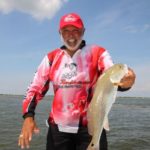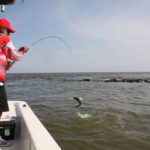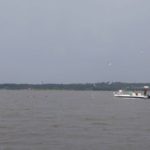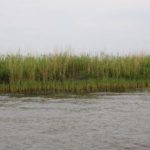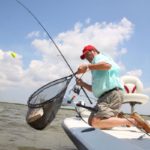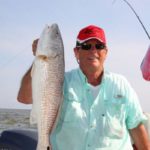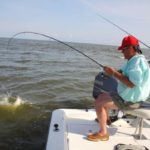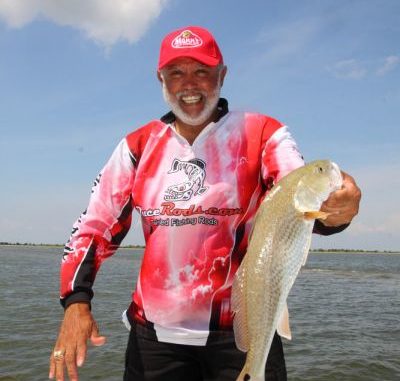
Vermilion Bay is often flooded with fresh water, but there’s no better place to snag a limit of redfish when things settle down in the heat of the summer.
Surrounded by boats, raucous gulls and terns dived into the green waters of Vermilion Bay near Weeks Island. And as quickly as lines could be cast, anglers were landing speckled trout.
My son and I wedged our bay boat in amongst the busy fishermen to get in on the action.
On his first cast, my son’s cork sank beneath the surface of the choppy water — hooking a redfish, when we were expecting a trout. Next a white trout pulverized his jig, where he noticed the Category 5 Suicide Croaker attached to it no longer had a tail.
Not wanting to switch baits with a fishing frenzy underway, he tossed his rig toward the birds again, getting another bite immediately with what was left of the bait.
This time he landed a good-sized speckled trout.
“See, Pops, no tail necessary,” he said matter-of-factly.
The fact is Vermilion Bay and the surrounding marshes can and does provide some great fishing. And the dog days of summer are when it really gets going in this part of the state.
Someone who spends a lot of time fishing the bay is Elvis Jeanminette, a native of Jeanerette and 37-year freshwater and saltwater tournament angler. And many of the tournaments the 55-year-old Lydia post master has fished in have taken place right in his own backyard out of Cypremort Point.
If you drew a line in the middle of this region starting on the outside of Marsh Island toward Weeks Island, what you’d find east is what’s known as the deltaic plain that is largely influenced by freshwater from the Mississippi and Atchafalaya rivers. The marshes influenced in this half of the area are soft sedimentary type.
To the west of the dividing line is the chenier plain, which is higher and more stable.
Because of this separation and the freshwater influence, Jeanminette said it’s important to know how to read the waters of this region.
“In the early part of summer, the tides are generally high when the river is up,” said Jeanminette. “You can tell because the water is over the marsh, so what happens is when the tides fall the bait comes out of those marshes. Redfish will school up and work up and down canals and shorelines. So it’s perfect.
“The tides go out and pull bait out, and it’s like a Burger King. At least that’s what I like to call it, anyway.
“Part of reading the water is to know when the tides are falling, because on a rising tide you\’re not going to catch as much. I’ve seen people make the mistake and go out there in the bay on a rising tide and fish for a couple hours and not catch anything. They get hot, sunburned, and they’re done.
“So, I always say try fishing the falling tides — it’s better.”
According to Jeanminette, another part of reading the waters is watching what the bait’s doing. It’s common to see shrimp, as well as shad, popping on the surface; the obvious telltale sign redfish or speckled trout are working below the bait.
“The later in the summer it gets, the water clears up and becomes more salty,” Jeanminette said. “The bait becomes more active.
“In the bay you’ll see that bait popping all along the surface of the water. And what’s happening when you see that is the redfish and trout are getting ready to start feeding. They run the bait up out of the water because it\’s the only place it can go.
“And if you watch closely, every now and then you\’ll see a swale where the fish actually caught something.”
When fishing with Jeanminette recently, our intent was to catch redfish at the mouth of the commercial canal in the northeast corner of Vermilion Bay near Weeks Island when the evening tide was falling hard.
Only the plan didn’t include a summer afternoon squall that churned up the bay and dumped a ton of freshwater into it — spoiling our trip.
We outran the evening storm, holing up at a friend of Jeanminette\’s camp on Cypremort Point to wait it out. And the angler said muddy water associated with such rain event often fool fishermen into leaving too soon.
“Saltwater is heavier than freshwater,” Jeanminette said. “When the water looks dirty, quite often it’s clear beneath the surface.
“That’s another mistake that people make. They see dirty water and quit before they get started. If it’s not green, they don’t want to fish it. Saltwater filters fast, so your pretty water is down below. I\’ve won tournaments in the commercial canal having the confidence, knowing the fish are still there under those conditions.”
Jeanminette fishes almost exclusively dead shrimp fixed to a 3/8-ounce jighead no matter what location he is fishing in the bay: canal, reef or drainage. In the commercial canal he said you want to fish the edge of the canal at the drop-off, where redfish run along it at the 14 or 15-foot depth.
About 10 miles to the west along the chenier plain in Vermilion Bay, there is less freshwater influence from river conditions. Anglers often find clearer and saltier water near popular fishing locations like Redfish Point, and those along and just outside of Southwest Pass.
The next day following our rain-delayed trip, I joined Jeanminette and Leon Minvielle, who regularly teams up with Jeanminette to fish tournaments, and we decided to fish the extreme western edge of Vermilion Bay just outside of Southwest Pass along the edge of Marsh Island.
We passed up popular fishing locations in the eastern side of the bay such the Trash Pile, Blue Point and the Hammock in exchange for saltier waters.
Places like Diamond Reef, Pavy Reef, Tete Butte Reef and other unnamed reefs outside Southwest Pass are all good for redfish. However, the pass itself is also good, as are many of the bayou inlets and drainages along the shorelines on the outer edges of Marsh Island in the bay.
“We’re not like Lafitte or Venice here,” said Minvielle, a New Iberia resident. “Those places are loaded with redfish and trout. Here the freshwater from the river hurts us. It gets better later in the year.
“My neighbor across the street showed me an unnamed reef that I fish quite often. There’s only a white PVC pipe that sticks out so you can find it.
“Four times out of 10, I might limit out on that particular reef, which isn’t bad. But generally we’ll move around to different locations, picking up a few each time.”
Besides fishing the tide and watching the bait, Jeanminette said anglers should look grassy outcroppings along shorelines, around which redfish will hang out.
In these cases he likes to toss spinnerbaits and bang the banks.
Jeanminette also said trenasses, drains and cuts in the marshes around Vermilion Bay are likely to hold reds.
But instead of fishing right on top of one of these drainages, he works the water between cuts, explaining that redfish will patrol the banks outside of the actual drains.
“You\’ll notice the swimming pattern of some of those fish is between drainages along the banks where you can catch a few fish,” Jeanminette said. “But, you\’ve got to know how to read the waters, because when the conditions are right — it’s on.”
Near Southwest Pass in a popular location known as the Rock Pile, we watched bait that could fill a cast net popping on the surface on a falling tide.
Jeanminette picked up several redfish, and Minvielle picked up a line screaming red that turned out to be what both anglers called a tournament fish — one that came in at 27 inches. Jeanminette said pair of fish like would probably win a tournament.
On our way in, Jeanminette and Minvielle decided we\’d try fishing Bayou Micheal. In the distance, we could see the birds diving near the mouth of this Marsh Island Bayou.
It didn’t take us long to drop the troll motor and start tossing plastics near the birds where shrimp were hitting the surface.
The frenzy didn’t last long and — though the fish weren\’t the monsters of Big Lake, Lake Ponchitrain or those at any of the close by Eugene Island rigs — they were good trout.
I had to change plastics a couple times, but not because they lost any tails. No matter when the fishing in Vermilion Bay is good, sometimes no tails are necessary.
Four popular Vermilion Bay waypoints
1. Redfish Point – 29’41.810 N. Lat./92’ 06.112 W. Long.
2. The Trash Pile – 29’47.913 N./Lat. 91’50.910 W. Long.
3. Diamond Reef – 29’31.607 N./Lat. 91’59.290 W. Long.
4. Pavy\’s Reef – 29’33.033 N. Lat./92’00.920 W. Long.
